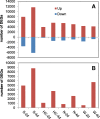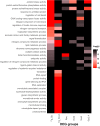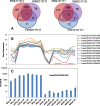Transcriptome dynamics associated with resistance and susceptibility against fusarium head blight in four wheat genotypes
- PMID: 30157778
- PMCID: PMC6116500
- DOI: 10.1186/s12864-018-5012-3
Transcriptome dynamics associated with resistance and susceptibility against fusarium head blight in four wheat genotypes
Abstract
Background: Fusarium head blight (FHB) of wheat in North America is caused mostly by the fungal pathogen Fusarium graminearum (Fg). Upon exposure to Fg, wheat initiates a series of cellular responses involving massive transcriptional reprogramming. In this study, we analyzed transcriptomics data of four wheat genotypes (Nyubai, Wuhan 1, HC374, and Shaw), at 2 and 4 days post inoculation (dpi) with Fg, using RNA-seq technology.
Results: A total of 37,772 differentially expressed genes (DEGs) were identified, 28,961 from wheat and 8811 from the pathogen. The susceptible genotype Shaw exhibited the highest number of host and pathogen DEGs, including 2270 DEGs associating with FHB susceptibility. Protein serine/threonine kinases and LRR-RK were associated with susceptibility at 2 dpi, while several ethylene-responsive, WRKY, Myb, bZIP and NAC-domain containing transcription factors were associated with susceptibility at 4 dpi. In the three resistant genotypes, 220 DEGs were associated with resistance. Glutathione S-transferase (GST), membrane proteins and distinct LRR-RKs were associated with FHB resistance across the three genotypes. Genes with unique, high up-regulation by Fg in Wuhan 1 were mostly transiently expressed at 2 dpi, while many defense-associated genes were up-regulated at both 2 and 4 dpi in Nyubai; the majority of unique genes up-regulated in HC374 were detected at 4 dpi only. In the pathogen, most genes showed increased expression between 2 and 4 dpi in all genotypes, with stronger levels in the susceptible host; however two pectate lyases and a hydrolase were expressed higher at 2 dpi, and acetyltransferase activity was highly enriched at 4 dpi.
Conclusions: There was an early up-regulation of LRR-RKs, different between susceptible and resistant genotypes; subsequently, distinct sets of genes associated with defense response were up-regulated. Differences in expression profiles among the resistant genotypes indicate genotype-specific defense mechanisms. This study also shows a greater resemblance in transcriptomics of HC374 to Nyubai, consistent with their sharing of two FHB resistance QTLs on 3BS and 5AS, compared to Wuhan 1 which carries one QTL on 2DL in common with HC374.
Keywords: Differentially expressed genes; Fusarium graminearum; Fusarium head blight; Pathogenesis; Plant defense; RNA-seq; Triticum aestivum.
Conflict of interest statement
Ethics approval
Ethics approval is not applicable.
Consent for publication
Not applicable.
Competing interests
The authors declare that they have no competing interests.
Publisher’s Note
Springer Nature remains neutral with regard to jurisdictional claims in published maps and institutional affiliations.
Figures














Similar articles
-
Characterization of QTL and eQTL controlling early Fusarium graminearum infection and deoxynivalenol levels in a Wuhan 1 x Nyubai doubled haploid wheat population.BMC Plant Biol. 2019 Dec 3;19(1):536. doi: 10.1186/s12870-019-2149-4. BMC Plant Biol. 2019. PMID: 31795937 Free PMC article.
-
Transcriptome dynamics of a susceptible wheat upon Fusarium head blight reveals that molecular responses to Fusarium graminearum infection fit over the grain development processes.Funct Integr Genomics. 2016 Mar;16(2):183-201. doi: 10.1007/s10142-016-0476-1. Epub 2016 Jan 21. Funct Integr Genomics. 2016. PMID: 26797431
-
Comparative transcriptomes reveal insights into different host responses associated with Fusarium head blight resistance in wheat.BMC Plant Biol. 2025 Apr 22;25(1):509. doi: 10.1186/s12870-025-06553-3. BMC Plant Biol. 2025. PMID: 40259243 Free PMC article.
-
[Current status and perspective on research against Fusarium head blight in wheat].Yi Chuan. 2018 Oct 20;40(10):858-873. doi: 10.16288/j.yczz.18-252. Yi Chuan. 2018. PMID: 30369469 Review. Chinese.
-
Management and resistance in wheat and barley to fusarium head blight.Annu Rev Phytopathol. 2004;42:135-61. doi: 10.1146/annurev.phyto.42.040803.140340. Annu Rev Phytopathol. 2004. PMID: 15283663 Review.
Cited by
-
Transcriptome Dynamic Analysis Reveals New Candidate Genes Associated with Resistance to Fusarium Head Blight in Two Chinese Contrasting Wheat Genotypes.Int J Mol Sci. 2023 Feb 20;24(4):4222. doi: 10.3390/ijms24044222. Int J Mol Sci. 2023. PMID: 36835630 Free PMC article.
-
Untargeted Metabolomics Reveals a Multi-Faceted Resistance Response to Fusarium Head Blight Mediated by the Thinopyrum elongatum Fhb7E Locus Transferred via Chromosome Engineering into Wheat.Cells. 2023 Apr 8;12(8):1113. doi: 10.3390/cells12081113. Cells. 2023. PMID: 37190021 Free PMC article.
-
Complex relationship between DNA methylation and gene expression due to Lr28 in wheat-leaf rust pathosystem.Mol Biol Rep. 2020 Feb;47(2):1339-1360. doi: 10.1007/s11033-019-05236-1. Epub 2019 Dec 23. Mol Biol Rep. 2020. PMID: 31873872
-
A recent shift in the Puccinia striiformis f. sp. tritici population in Serbia coincides with changes in yield losses of commercial winter wheat varieties.Front Plant Sci. 2024 Oct 28;15:1464454. doi: 10.3389/fpls.2024.1464454. eCollection 2024. Front Plant Sci. 2024. PMID: 39529930 Free PMC article.
-
Transcriptomic analysis of two Chinese wheat landraces with contrasting Fusarium head blight resistance reveals miRNA-mediated defense mechanisms.Front Plant Sci. 2025 Feb 28;16:1537605. doi: 10.3389/fpls.2025.1537605. eCollection 2025. Front Plant Sci. 2025. PMID: 40093609 Free PMC article.
References
-
- Mesterházy Á, Bartók T, Mirocha CG, Komoróczy R. Nature of wheat resistance to fusarium head blight and the role of deoxynivalenol for breeding. Plant Breed. 1999;118:97–110. doi: 10.1046/j.1439-0523.1999.118002097.x. - DOI
-
- Buerstmayr H, Ban T, Anderson JA. QTL mapping and marker-assisted selection for fusarium head blight resistance in wheat: a review. Plant Breed. 2009;128:1–26. doi: 10.1111/j.1439-0523.2008.01550.x. - DOI
MeSH terms
Substances
Grants and funding
- project J-000412/Canadian Agriculture and Agri-Food Growing Forward 2 program
- projects J-000008 and J-001580/Genomics Research and Development Initiative
- National Wheat Improvement Program/Western Grains Research Foundation and Agriculture and Agri-Food Canada
- "Canadian Wheat Improvement" project A1-011652/National Research Council Canada
LinkOut - more resources
Full Text Sources
Other Literature Sources
Molecular Biology Databases
Research Materials

